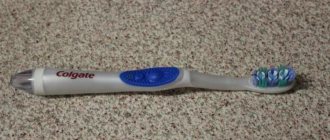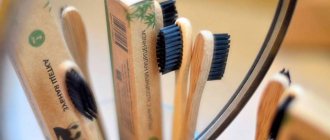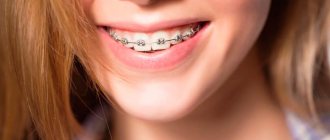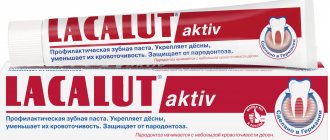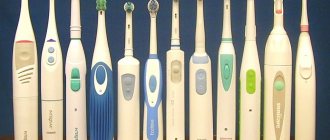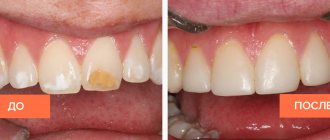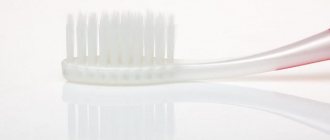Each of us to brush our teeth from childhood . With age, this procedure becomes so habitual that we perform it automatically while half asleep.
After such brushing, you may feel that your teeth have not been brushed thoroughly enough.
This happens because a regular brush is not enough for proper oral care.
Even electric toothbrushes do not completely clean all the edges and surfaces of the enamel, do not penetrate into the interdental spaces and hard-to-reach areas of the oral cavity due to their large size.
Remember! Therefore, plaque and tiny food debris accumulate there. This provokes the formation of caries and bad breath.
For such areas of the oral cavity, more precisely targeted, local cleansing is necessary . In this case, a mono-tuft toothbrush will help .
What it is?
A monotuft toothbrush differs from the classic example in its non-standard shape .
In appearance, it more closely resembles an ordinary stick, with a tuft of bristles attached to the end. A mono-tuft brush consists of an elongated thin handle and a single thin tuft of bristles located perpendicular to the handle. The functionality of the device is similar to a brush and toothpick. It does an excellent job of removing bacterial plaque along the entire length of the crown due to its full coverage of the tooth neck area.
The device can be used at any age, both with and without toothpaste. The brush has no contraindications or restrictions. The unique design does not cause difficulties during use.
Appearance
A monotuft brush differs from its traditional counterpart in that it consists of one bunch of bristles located on a small round head.
In different models, the end of the beam can be pointed or straight.
The brush is intended for everyday use both in the absence of oral pathologies and when wearing orthodontic appliances.
Depending on the length of the villi, such a device can be used by both adults and children.
Who invented it?
The ancient peoples of Africa can be considered the inventors of the monotuft brush . They used branches of the Miswak and Sotiu trees to clean their teeth. Thin branches were cut into small pieces, soaked in water, and then soaked on one side.
This is how the “progenitor” of the modern mono-beam brush was made. Modern manufacturers have taken advantage of the idea of their ancestors and developed a similar device, only using the latest materials and technologies.
How to properly care for braces: 10 dentist recommendations
Dentists recommend not only using special devices and toothbrushes for braces , but also following simple care rules. Namely:
- Teeth should be brushed after every meal. This is important, because when eating, braces retain a lot of leftover food. They quickly become the cause of bacteria, which leads to inflammation and caries.
- While wearing braces, it is better to avoid hard foods (nuts, seeds, popcorn), as they can damage the orthodontic structure.
- It is undesirable to consume viscous products (halva, toffee, chewing gum). Such food not only gets stuck between the teeth and the elements of the braces system, but can cause damage to the lock on the tooth. Problems especially often arise with toffee and chewing gum.
- It is recommended to avoid foods that are too hot or too cold. Temperature changes destroy the substance that holds braces on the teeth.
- Do not use ultrasonic brushes for cleaning. They are good and can and even should be used, but they are not designed for the presence of braces and other foreign elements on the teeth.
- It is undesirable to eat products with natural or artificial dyes - all the paint will eventually remain not only on the enamel, but also on the braces (especially on cheap models).
- Visit the orthodontist in a timely manner so that the doctor can monitor the condition of the teeth and recommend the remedies that need to be used to normalize the situation.
- Combine careful care with proper nutrition. Make sure your diet contains calcium, magnesium, vitamins (especially C, D), fluorine, phosphorus, proteins, etc. It is useful to include dairy products, fish, vegetables and fruits in your menu.
- Don't forget about dental floss. You need to buy it specially, because the regular one is not suitable for braces. The most convenient option is Superfloss thread. It is divided into small pieces and has a thin and hard end. It is easy to thread under the arch and stick into hard-to-reach places.
- Choose your toothpaste carefully. A good toothpaste will help reduce tooth sensitivity. This is especially important for those who suffer from discomfort associated with wearing braces. Before purchasing, examine the tube and make sure that the paste is intended to strengthen enamel.
You cannot ignore the advice of dentists, because this will negatively affect the health of your teeth. Take the time to care for your oral cavity; it is already subject to increased stress due to braces.
Advantages and disadvantages
Having appeared not so long ago, the mono-beam brush immediately became in demand. This popularity is due to the advantages that distinguish this product from similar products:
- high quality of crown cleaning due to the unique structure of the bristles;
- due to the easy penetration of the bristles into the gum pocket area, high-quality removal of bacterial deposits ;
- the shape of the head allows for targeted cleaning , which is very important if there are injuries and ulcerations on the mucous membrane;
- The advantage is a wide selection of bristle types and head sizes , so that the device can be used even by children;
- copes well with removing dirt from orthodontic appliances and dentures .
In addition to its advantages, this design also has some disadvantages:
- the duration of the cleansing procedure, since the head has a small area of influence;
- need to be used together with a standard brush. The monobeam option acts only as an auxiliary one .
Types of orthodontic brushes
Due to the special structure of braces, it is not possible to use ordinary oral hygiene items to clean them. The use of ordinary brushes does not help to effectively clean the oral cavity, because the bristles simply do not reach many places. But scientists have developed many different specialized brushes for cleaning braces , which take into account all the features of this bite correction system.
There is an opinion that while wearing braces, you can use a regular brush, the main thing is to take a product with soft bristles. Dentists think differently: studies have shown that ignoring specialized products doubles the likelihood of developing caries!
V-shaped
The V-shaped brush is very similar to a regular brush. The only difference is that in the central part in the longitudinal direction the product has a reduced bristle length. It is believed that this form allows you to simultaneously clean the enamel, on which there are no braces, and the braces themselves. Among these brushes there are standard ones (with bristles) and non-standard ones (with rubber pads or rubber bristles). Whether it is worth using newfangled solutions should be checked with a doctor.
Standard V-shaped brushes
Monobeam
A mono-tuft toothbrush for cleaning braces has only one tuft of bristles on a plastic handle. It is very thin, so it easily cleans surfaces that are inaccessible to ordinary brushes. This product is used after a regular brush and brush: it is designed to remove all those small food debris that other cleaning devices cannot reach.
Some people think that using a single-tuft brush is not necessary, but this is not true. It helps remove dirt around the locks, which is very important. If you do not clean this area, you will see discoloration of the enamel after your braces are removed.
An example of a monotuft brush and its application
Electrical
Electric brushes can be used with braces , but be very careful. If you bought a model in which the head makes rotational movements, you cannot use it - the bristles may get stuck in the metal structures. Dentists do not recommend using a working head in the area of braces; it is dangerous and can lead to breakage of the locks. In addition, electric models are designed for routine care, so they are not enough for full care.
You can combine specialized tools such as brushes and mono-tuft brushes and an electric model. In this case, the surfaces of the teeth that are not covered by braces are automatically cleaned, and the rest of the enamel is cleaned manually.
Advice! If your budget allows, in addition to a special brush, also buy an irrigator. It does not replace brushing your teeth, but helps remove plaque and food debris with water. You can also rinse your teeth with medications, this reduces the risk of inflammation and gum disease.
Cleaners
Brushes for braces are used to clean the spaces between the arch and teeth. They consist of a holder and replaceable heads, each of which lasts no more than 2 weeks. The holder can be of any shape and often resembles a brush handle. The head itself looks like a small wire base on which there are bristles sticking out in all directions.
Types of dental brushes and an example of their use
Cleaners are classified according to the following parameters:
- the shape of the working part. Models come in conical and cylindrical. Conical ones taper towards the end, cylindrical ones have a constant nozzle width;
- the stiffness of the bristles, which can be hard or soft. The latter is used for sore gums or increased sensitivity;
- size. It is recommended to use brushes of different sizes for different teeth, because... the distance between the elements of the dentition can vary over a fairly wide range.
Regardless of their hardness, brushes do not last long. It is recommended to take them in sets so as not to run to the store for your next purchase as soon as the bristles of the brush you are using wear out.
Sizes of brushes and features of interdental cleaning
Sets
To care for your teeth during the period of bite adjustment, you need a lot of equipment. You don’t have to buy them separately: you can immediately buy a set, which will include a toothbrush with braces , a brush, and a mirror. The main thing is that such a set includes all the products necessary for care.
Two examples of dental care kits
The minimum configuration is as follows:
- v-shaped brush;
- toothpaste;
- waxed floss for dental purposes;
- floss toothpicks or dental brushes;
- mono-beam brush;
- mirror.
Even such a small specialized kit will help you take full care of your teeth. An additional advantage of buying a set is that it is usually sold in special packaging that is convenient to carry with you. The kit is also suitable for travelers. But do not forget that brushes quickly become unusable and need to be replaced.
Advice! If you find the kit inconvenient for constant use, you can purchase two sets of accessories. You will carry one with you when eating at a restaurant or dining out, and use the other at home.
Design features
Compared to the classic version of a toothbrush, the mono-tuft product has a smaller cleaning head and a thinner handle. Both synthetic and natural materials can be used to make the beam.
The villi, which are thin and have excellent elasticity, perfectly remove food debris, much better than dental floss and toothpick.
Each of the bristles is a collection of micro-bristles, which ensures a tight fit of the cleaning head to the enamel.
The thin handle and curved working surface make it possible to comfortably position the device in the oral cavity and allow it to penetrate into the most inaccessible places. For example, you can easily clean your wisdom teeth efficiently.
How to use dental floss?
Take 45 cm of dental floss. Wrap most of it around your fingers, leaving 5 cm for cleaning. Hold the floss between your thumb and forefinger and move it up and down
: down - on one side of the tooth, up - on the other.
Be gentle and don't push too hard. Let the movements be light and not sharp, otherwise you may accidentally injure your gums. Move from tooth to tooth, using a new, clean section of floss each time. To finish flossing and pulling it out, use the same up-and-down motion. Here is a video demonstrating the technique.
Instructions for use
In order to get the maximum benefit from using a mono-beam brush, you need to read the detailed instructions. The teeth cleaning algorithm should consist of the following steps:
- The brush is wetted in water to ensure better glide over the enamel. If necessary, toothpaste is squeezed onto the cleaning head, however, the effectiveness of the application will not decrease if you do not use this hygiene product.
- The oral cavity should be mentally divided into 4 segments. The cleaning process begins with the most distant tooth. Making circular sweeping movements, you must follow from the gum pocket to the chewing surface.
- The cleaning head should be positioned at an angle of 450 to the side of the tooth being cleaned.
- During the hygiene process, you should not apply excessive pressure so as not to injure the soft tissues of the oral cavity.
- Attention should be paid to the outer and inner sides of the tooth, the chewing surface and the interdental space.
- The front teeth and cutting surfaces should be cleaned more intensively.
- It should take at least 10 seconds to process one unit.
See also: How to repair an air conditioner
To improve the quality of cleaning the oral cavity, it is recommended to use a monotuft brush in conjunction with the classic version.
How to choose a brush based on the shape of the bristles
The bristles of a toothbrush can be single-level, two-level, three-level and multi-level. Research shows that multiple levels of bristles provide better cleaning between teeth and gum pockets.
Based on the arrangement of the beams, three types of brushes are distinguished:
- Hygienic: with even and straight bundles of the same length. This is a very ordinary brush with minimal functionality. Usually such models are bought for children.
- Preventive: the beams are located in different directions, have different lengths and even rigidity. There may be rubber bristles on the sides of the brush that massage the gums while brushing your teeth.
- Special: designed for cleaning braces, implants and other structures. Such brushes are sold in pharmacies and can be made to order. It is better to buy them after consulting a dentist.
These are the main parameters of toothbrushes. Today, many models are available with additional functions. If you wish, you can choose a good brush that will massage your gums, clean your tongue, etc.
Selection rules
A wide range of oral care products forces the consumer to choose products according to certain selection criteria. What should you pay attention to when choosing?
Cleaning head
The cleaning head should be small and round in shape
.
Choose a head with smooth edges
to avoid injury to the oral cavity. The effectiveness of cleaning hard-to-reach areas depends on the correct size of the cleaning surface.
For children, it is recommended to use a head up to 7 mm wide. For adults, a maximum width of 11 mm is acceptable.
Hardness degree
Manufacturers offer a choice of 5 degrees of bristle hardness, each of which has its own purpose:
- sensitive (0.10 mm) – the softest bristles are created for light intensity cleaning from accumulated bacteria, and are intended mainly for children 2-5 years old and for people with increased tooth sensitivity;
- soft (0.12 mm) – soft-hard bristles affect the oral mucosa and qualitatively polish the enamel without damaging it. Recommended for pregnant women, children 5-10 years of age and people suffering from pathologies of gum tissue or periodontitis;
- medium (0.15 mm) – a medium degree of hardness is suitable for children over 10 years old, people with healthy teeth, as well as those who have superficial carious lesions;
- hard (0.17 mm) – has enhanced cleaning properties, intended for people whose teeth are prone to constant tartar formation;
- extra - hard (more than 0.17 mm) - the most rigid bristles are produced for cleaning removable braces and dentures.
The following video contains information about the advantages of monotuft toothbrushes and the rules for choosing them.
Pen
This part of the brush should be of medium thickness, ergonomic and with silicone inserts to prevent slipping during the procedure.
But the main selection criterion is the neck of the product, which must be curved to ensure a high degree of cleansing of hard-to-reach places in the oral cavity.
Bristle material
Natural and artificial materials are used to make fibers. In the first case, the pile is distinguished by significant softness and elasticity.
However, products with bristles made from natural fibers have some disadvantages:
- high cost;
- Compared to synthetic materials, short service life;
- The bristles quickly accumulate bacteria due to the flat structure of the villi.
Nylon and polyurethane are superior to natural fibers in terms of stiffness and elasticity of the bristles. But bristles made of artificial material quickly lose their shape when exposed to hot water.
For high-quality hygiene, preference should be given to brushes with bristles from 0.17 to 0.2 mm.
Number of villi
When choosing a device for a child, you should give preference to products with 700 fibers, and for an adult – 1,000 or more.
Additional activities after cleaning
In addition to directly brushing teeth during orthodontic treatment, some other manipulations may be required to improve the patient’s quality of life - this is rinsing the mouth and working with wax.
Mouthwash
Dentists recommend using mouthwash daily. This allows you to quickly freshen your breath, while chewing gum remains an unaffordable luxury for patients with braces.
In addition, regular rinsing of the mouth with antiseptic solutions helps relieve inflammation, which especially often makes itself felt in the first days of wearing braces.
Why do you need wax?
If you buy a set for cleaning braces, then in the vast majority of cases it will also contain wax in addition to the already familiar listed tools. Why is it needed?
It is no secret that the sharp edges of braces and even the arch can cause microtrauma to the mucous membrane of the tongue, lips and cheeks. This is especially noticeable in the first 2-3 weeks of wearing braces, when all the known shortcomings of this orthodontic system are maximally manifested.
To avoid the formation of wounds, bleeding and generally improve the patient’s quality of life and increase his loyalty to treatment, orthodontists recommend the active use of wax. A small amount of it must be kneaded in your hands and applied to the part of the bracket with sharp edges. Gradually, this will no longer be necessary, as the oral mucosa adapts to the structure on the teeth.
Care
Not only your teeth need care, but also your brush itself. During its use, you should adhere to some rules:
- Each time after use, the brush must be rinsed with a stream of hot water . But do not use boiling water, as this may cause deformation of the bristles.
- At least once a week you need to treat your device with an antibacterial solution . To do this, you can use a solution of regular chlorhexidine or purchase a special product. The greatest antiseptic effect is observed after soaking the brush in the solution for several hours.
- For storage you need to use only special containers or holders . Storing in a regular glass with other brushes will lead to the accumulation of bacteria on the bristles, which can cause the risk of developing dental pathologies.
- During storage, the brush must be positioned with the head up . Thanks to this, it dries faster, which prevents the accumulation and development of microbes.
- It is imperative to change the device after using it during infectious diseases.
- Do not forget that the maximum service life of this device is 3 months . After this, it must be replaced.
See also: What are ZTE routers
Some manufacturers have equipped monotuft brushes with a special indicator that shows the degree of wear of the bristles. The lower the color saturation of the indicator, the greater the wear of the bristles.
Additional functions of toothbrushes
These additional features include:
- Rubber inserts on the handle that prevent it from slipping out of your hand.
- Embossed pad for cleaning the tongue and cheeks, located on the back of the head.
- An indicator of wear is bristles, which differ in color from the main mass of the tufts. If they fade, the brush needs to be replaced.
- Ribbed surface or rubber bristles for gum massage.
Some brushes release silver ions during use, which enhance the whitening effect of toothpastes. With their help it is easier to get rid of plaque.
Price
The cost of a monotuft brush has a wide range from 190 to 1000 rubles . The brand of the product is of primary importance in this regard. For example, little-known brushes cost only 190 rubles .
Purchasing a similar model from the popular Curaprox will cost 800 rubles or more. The cost is also affected by the design model.
In addition to the standard sample, the market offers brushes with replaceable heads costing from 400 to 700 rubles . You can also find a double-sided model, the price of which starts from 150 rubles .
Who needs a mono-tuft toothbrush?
Who do dentists recommend using these brushes to clean their teeth?
Firstly, for patients who are prescribed an orthodontic toothbrush (mainly those wearing structures on their teeth, in particular braces). If this mechanism is fixedly fixed on the teeth, then areas are formed that simply cannot be treated with a regular toothbrush. Such designs, by the way, make the gums and enamel sensitive and vulnerable.
Mono-beam brushes are much more gentle than regular brushes and will clean the tooth surface without disturbing the gums; they will remove food particles from under the braces without damaging their mechanism. You should act with careful “sweeping” movements. In this case, it is better to choose a tool with long and soft bristles.
For people wearing implants and dentures, we can recommend “Curaprox” - toothbrushes designed specifically for cleaning them. The device will be useful both for crowded teeth and for wide interdental spaces – “chapped teeth”. This brush can be used in hard-to-reach places in the oral cavity.
It will be useful for everyone as an additional effective means of dental hygiene in “difficult” places, be it molars, wisdom teeth or interdental spaces.
What to do if you don’t have a brush and toothpaste at hand?
Then use fluoride mouthwash
. It won’t replace a full cleaning, but it will give you a feeling of freshness and remove at least some of the bacteria.
In general, the rinse is a useful addition to regular teeth brushing: it reaches places that are difficult to clean with a brush and toothpaste. Cosmetic mouthwash (the regular kind found on the supermarket shelf) can temporarily remove bad breath. Therapeutic (available over the counter) can kill bacteria, relieve gum disease (gingivitis), and control plaque and tooth decay. It is better to use it, but select it together with your dentist.
How to brush teeth with braces and how much?
How to brush teeth with braces?
Ideally, brush your teeth with braces after every meal. But this does not always work out. Therefore, you should at least rinse your mouth with water or mouthwash after eating.
You should brush your teeth at least 2 times a day in the following sequence:
- Using a regular brush and paste, we clean the surfaces of the teeth on which braces are not glued;
- Using an orthodontic brush, we carry out reciprocating movements along surfaces with “locks”;
- Use a brush to clean the spaces under the arch, above and below the braces;
- Using a mono-beam brush, we clean the outer surface of the “locks” and the surface of the tooth around each bracket;
- We use floss (dental floss) to clean the interdental spaces, and, if necessary, around the “lock”;
- Using an irrigator, we wash out the remaining “dirt” between the teeth and massage the gums.
Indications for use
For your information! This model of cleaning device is recommended for use in the following cases:
- Wide spaces between teeth , conditions after tooth extraction.
- Wearing braces, retainers, bridges, implants and other dental structures.
- Large crowding of teeth or their irregular growth.
- In comprehensive oral hygiene, for more thorough cleansing.
Rating of high-quality mono-beam toothbrushes for 2021 from
Popular models among the entire range of the company are the “Solo” cleaning brushes – “CS 1006 single” and “CS 1009 single”. They are suitable for removing plaque, cleaning braces, cleaning hard-to-reach tooth surfaces and the periodontal sulcus.
See also: Sushi sets on favorable terms from Makarollich
The product is shipped from Switzerland. The body is made of plastic and has different colors, as well as the bristles, which are made of synthetics.
The difference between the two types of brushes is the size of the bristles, design and purpose. However, both designs consist of the same number of rounded fibers.
The patented bristle system creates a dense, highly effective cleaning surface. Villi absorb moisture less, compared to nylon material, and retain their cleaning properties up to 60% better.
The handle and compact head with a slight tilt in the cervical area ensure the correct position of the brush: oral care at the right angle.
Mono-tuft brushes 1006 and 1009 respectively, various design options
Product Specifications:
Name: "CS 1006" "CS 1009"
| Purpose: | removing plaque from each tooth separately | for cleaning around implants, braces, attachments |
| Hardness level: | soft | soft |
| Pile length (mm): | 6 | 9 |
| Number of cleaning elements (pcs.): | 810 | 810 |
| Head Shape: | resembles half a ball | rounded |
| Color: | any | any |
| By price (rubles): | 390 | 390 |
Curaprox Solo CS 1006 singleAdvantages:
- design;
- perfectly removes plaque from tooth enamel, especially in the gum area and joints (multi-level bristles ensure ideal cleaning);
- does not injure the gums;
- high level of wear: after several months of operation, retains its original appearance;
- ergonomic shape of the holder (comfortable).
Flaws:
- not identified.
CURAPROX CS 1009 Single & Sulcular
The monotuft model produced by Curaprox is equipped with a thousand polyester fibers 9 mm long.
Used to clean the oral cavity and parts of dental systems.
Thanks to the special coating of the fibers, the device does not scratch the enamel and does not injure the gums.
The cost of the model is 520-550 rubles.
Watch the video about the use of Curaprox mono-beam toothbrushes.
Miradent I-Prox P
Used to remove plaque from closely spaced teeth, braces and bridge structures.
The replacement head can be positioned at an angle of 60º or 120º relative to the holder.
The bristles of the head have a pointed shape for better plaque removal.
The cost of the product is 300 rubles.
Edel White
The product from a Swiss manufacturer is intended for the care of implants, bridges, as well as cleaning teeth in the presence of wedge-shaped defects.
The head with pointed bristles of medium hardness cleans the space between the enamel and the elements of the bracket system.
The set includes 2 monotuft brushes and a protective cap.
The cost of the set is 260 rubles.
TePe Compact Tuft
Equipped with a small curved head. The high density of the bristles allows you to effectively clean bacterial and food plaque from the surface of the teeth.
Dentists recommend using this product for patients with fixed orthodontic appliances.
The cost of a brush in stores and pharmacies is 320-350 rubles.
Dentaid Vitis Implant Monotip
Designed for cleaning areas of dental structures with minimal access.
The bristles of the device have medium hardness and are rounded at the ends to avoid damage to the enamel.
The cost of the product is 360 rubles.
Jordan Interbrush
Intended for use by children aged 6 to 8 years. Designed for cleaning teeth and gum lines.
Can be used to remove plaque in hard-to-reach areas of the oral cavity with installed braces.
The thin handle fits comfortably in a child's hand while brushing teeth. The cost of the product is 150 rubles.
Sources
- https://zubovv.ru/krasota-i-uxod/zubnyie-shhetki/dlya-chego-prednaznachena-monopuchkovaya.html
- https://www.vash-dentist.ru/krasota-i-uxod/zubnyie-shhetki/monopuchkovaya-podrobnoe-opisanie.html
- https://dentist-pro.ru/krasota-i-uxod/sredstva/zubnye-shhetki/chto-vybrat-klassicheskuyu-ili-monopuchkovuyu.html
- https://FB.ru/article/264639/zubnaya-schetka-monopuchkovaya—nezamenimyiy-pomoschnik-v-chistke-trudnodostupnyih-mest
- https://inwomen.ru/kak-pravilno-chistit-zuby-s-breketami-posle-edy-s-pomoshhyu-zubnoj-shhyotki-spetsialnoj-ortodonticheskoj-zubnoj-shhyotki-monopuchkovoj-shhetki-yorshikom-zubnoj-nityu- irrigatorom-dlya-polosti-rta-chto/
- https://vyborok.com/rejting-luchshih-monopuchkovyh-zubnyh-shhetok/
- https://dr-zubov.ru/krasota-i-uxod/sredstva/zubnye-shhetki/kak-ne-oshibitsya-v-vybore-monopuchkovoj.html
Did the article help you?
Andrey
Ask questions
Ask questions and write answers in the comments
Conclusion
According to buyers, the best representatives of monotuft brushes for 2021 are foreign companies. The table provides a brief overview of their products, as well as the price segment for them. Intuition will tell you which company is better to purchase a product after studying and comparing all the data.
Important! The tooth cheek should be selected taking into account the structural features of the dentition, the sensitivity of the gums, and the fixed structure, if any.
Table - “List of the best monotuft brushes for 2021”
| Name: | Manufacturer: | Hardness level: | To whom: | Average price (rubles): |
| "CS 1006 single" | "Curaprox" | soft | children and adults | 390 |
| "CS 1009 single" | soft | adults | 390 | |
| "Compact Tuft" | "TePe" | soft | 0+ | 300 |
| "Interspace Medium" | average | adults | 360 | |
| "Interspace Soft" | soft | everyone | 350 | |
| "Vitis Implant Monotip" | "Dentaid" | tough | 12+ | 200 |
| "I-prox P" | "Miradent" | average | adults | 320 |
| "End-tuft" | "PresiDENT" | average | adults and children | 190 |



